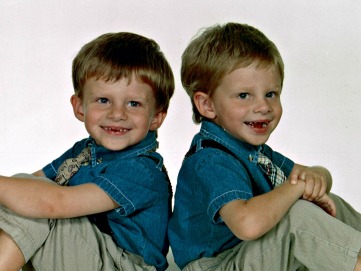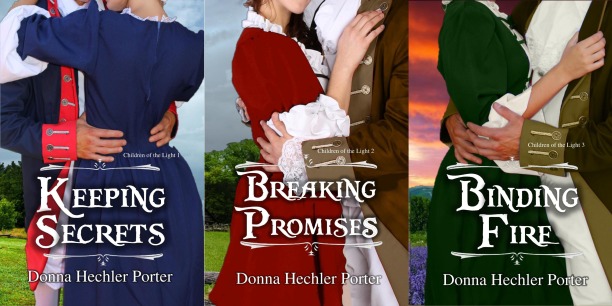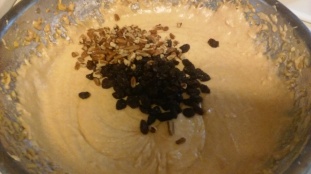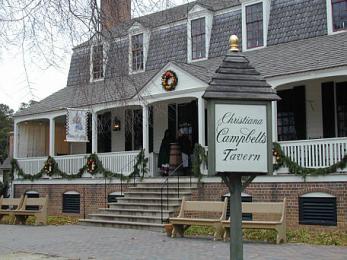Today, April 20th, is National Look-Alike Day. Around the Porter household, however, EVERY day is look-alike day when you are the mother of “probably” identical twin boys.
I say probably, because at the time of their birth, 17 1/2 years ago, DNA tests were extremely expensive and not recommended unless the health of one or more infants was at risk. As with everything else, as the years rolled onward, such tests now cost much less, but we never got the test done.
And actually, my boys are more than likely mirror-image twins. Several moles they share are on opposite sides of the body. Their teeth came in on opposite sides. They tend to part their hair on opposite sides, and one is left handed while the other is right handed.
Mirror image is not a type of twinning, but merely a term for describing physical characteristics of mono-zygotic twins, which are twins that develop from a single fertilized egg. Mirror image characteristics occur when the twinning, or division, occurs a week or more after fertilization, rendering the twins, in effect, one person for at least a week. On the contrary, most twins have separated within the first few days of conception, and of course, those that never separate become conjoined twins in some form or fashion.
Oftentimes, these types of twins share more than just physical characteristics, and growing up, my boys were two peas in a pod. We were a very eclectic and not so electic family to say the least, as they shared a number of things in common as well as differed in a number of extremes. They both played the piano and won awards, although one son excelled beyond the other. They both played baseball, and while both are athletic, the other twin, not the musical one, seemed to excel in sports. One son can take apart almost anything and put it back together, while the other has no clue whatsoever to do when something breaks. One is very emotional, the other more subdued and less likely to get angry or upset.
they shared a number of things in common as well as differed in a number of extremes. They both played the piano and won awards, although one son excelled beyond the other. They both played baseball, and while both are athletic, the other twin, not the musical one, seemed to excel in sports. One son can take apart almost anything and put it back together, while the other has no clue whatsoever to do when something breaks. One is very emotional, the other more subdued and less likely to get angry or upset.
And, it gets even weirder. We use to play a game called “What’s next?” I would ask a question and they each had to blurt out the first thing that came into their mind. At first they were simple questions. What is your favorite color? What was the best book Mom ever read to you? What is your favorite animal? The answers were ALWAYS the same, which was the fun part of the game, especially if we played it in front of other people and they asked the questions.
But then, it got weird. I remember asking What’s your favorite song? Both said, “Number 5 on the Last of the Mohicans CD.”
I very nearly drove the car off the road. Seriously? Needless to say I, which doesn’t happen often, was at a loss for words. The questions and answers got stranger from there, for being a identical twin goes beyond looking alike, and mirror image twins, it is stated, share more in common than most.
When writing my Children of the Light Series, I never intended to make being twins such a big part of Annie and Katie’s lives. I knew I had to somehow make Annie more of an “oldest child” if she was to carry out the story as I was planning it as she was the second daughter behind Sarah. To do so, I needed to make her have felt weighty responsibilities as a child. By making older sister Sarah the sickly type, and giving twin sister Katie a disability from birth in the form of a slightly turned foot, Annie was forced to take on the role of caretaker of her sisters, a role that normally would have fallen to Sarah.
From there, the characters grew organically from the story, so that by the time Breaking Promises begins, the 2nd in my series, Annie, despite the fact she is the dominant twin, is still reeling a bit from Katie’s marriage the previous year and her subsequent move to the backcountry and out of Annie’s life. Katie’s independence is a blow to Annie, and when Katie’s life takes a dangerous turn, it was easy to create a story line in which Annie’s nightmares feature her sister’s pain even though Katie has told the family nothing of her plight in her letters home.
And as with all twins, Annie and Katie have to part ways and become their own people. It’s a struggle at times, even as one twin works to do so while the other works to hold him or her back. Later, the roles will switch. Back and forth. Forth and back. All the while, there is, I have come to realize, a safety net in that look-alike relationship that is both comforting and confining. My own boys get irked when others have asked them what it is like to be a twin. How do we know? We have nothing to compare it to?
And indeed, there have been times as a mother of such twins that I have felt very much like Mary Langdon McKecknie Cayle:
“Annie? Thou hast not answered me. How do you know Katie needs you?”
“The same way I knew something was wrong last fall.”
Was that why the child was so wan lately? Was it the reason her clothes were dripping around her body, and why at times, during the day while here on the weekends, Mary would catch her sleeping? Annie was never a napper, not even as a child. When she fell asleep in the day it was utter exhaustion or a coming sickness.
Mary had simply thought perhaps she was working too hard. She knew there had been some trouble at the shop since Andrew Cayle, Amon’s brother, had married Mildred Foster nearly six months previous. While Andrew Cayle was the schoolmaster, he had beaten Annie for bringing kindling to school instead of firewood. Mary had not found out of it until the child had gotten sick with a fever. By then, the welts were fresh scars. Annie had insisted, however, that the man had not hurt her since his marriage to Mildred nor had Jackson bothered her unnecessarily.
Was it not that at all that had the child at sixes and sevens? Was it Katie?
“Annie, I cannot pretend to understand this sort of unspoken communication you have with your sister.” She had given up trying to understand long ago. “But you cannot go. ‘Tis madness.”
Annie’s eyes tied themselves into painful knots. “But I will have no peace until I see her.”
(Excerpt from Breaking Promises, Children of the Light 2)

 I could probably make a case that the reason the Porter boys (and man) do NOT like them is because they are so much healthier than the white potatoes. Sweet Potatoes have a bit more fiber, Vitamin C, and Calcium, while white potatoes weigh in with a bit more magnesium, protein, potassium, and also have a tad bit of iron as well. However, sweet potatoes are loaded with Vitamin A, while white potatoes are fairly deficient. One chart online shows white potatoes coming in with 14 IU of Vitamin A, while sweet potatoes weigh in with 22,000 IU. That is a significant difference, especially when considering that Vitamin A is a cancer fighter as well as essential for eye health. And while white potatoes certainly have a place in our diets, sweet potatoes have less carbs, and far less calories and sugar than white potatoes.
I could probably make a case that the reason the Porter boys (and man) do NOT like them is because they are so much healthier than the white potatoes. Sweet Potatoes have a bit more fiber, Vitamin C, and Calcium, while white potatoes weigh in with a bit more magnesium, protein, potassium, and also have a tad bit of iron as well. However, sweet potatoes are loaded with Vitamin A, while white potatoes are fairly deficient. One chart online shows white potatoes coming in with 14 IU of Vitamin A, while sweet potatoes weigh in with 22,000 IU. That is a significant difference, especially when considering that Vitamin A is a cancer fighter as well as essential for eye health. And while white potatoes certainly have a place in our diets, sweet potatoes have less carbs, and far less calories and sugar than white potatoes. Anyhow, loving sweet potatoes like I do (I am a southeast Texas girl at heart, after all), and I am also fool for pecans and raisins, too, I saw the recipe for Sweet Potato Muffins, which are a staple apparently at Williamsburg, Virginia’s Christiana Campbell’s Tavern, and I knew I had my cooking challenge for April. And this one was a keeper! Even Mr. Porter remarked that they were good, and he is a hard sale on any potato that is not white.
Anyhow, loving sweet potatoes like I do (I am a southeast Texas girl at heart, after all), and I am also fool for pecans and raisins, too, I saw the recipe for Sweet Potato Muffins, which are a staple apparently at Williamsburg, Virginia’s Christiana Campbell’s Tavern, and I knew I had my cooking challenge for April. And this one was a keeper! Even Mr. Porter remarked that they were good, and he is a hard sale on any potato that is not white.
 art, autumnal flavor. I will definitely be making this in the future!
art, autumnal flavor. I will definitely be making this in the future!
 they shared a number of things in common as well as differed in a number of extremes. They both played the piano and won awards, although one son excelled beyond the other. They both played baseball, and while both are athletic, the other twin, not the musical one, seemed to excel in sports. One son can take apart almost anything and put it back together, while the other has no clue whatsoever to do when something breaks. One is very emotional, the other more subdued and less likely to get angry or upset.
they shared a number of things in common as well as differed in a number of extremes. They both played the piano and won awards, although one son excelled beyond the other. They both played baseball, and while both are athletic, the other twin, not the musical one, seemed to excel in sports. One son can take apart almost anything and put it back together, while the other has no clue whatsoever to do when something breaks. One is very emotional, the other more subdued and less likely to get angry or upset.

 In Life on Little River, it was the latter which overwhelmed me at first. I could feel the dust in my mouth as a young Braxton Hickman wandered his neighborhood with his buddies. I could smell the summer moisture rising from the ground, and my own memories rose to the surface, both those I had lived and those I had heard about (for even as a child I was more than willing to listen to stories about the past.) Those were good, sweet days my own children will never experience, for the world is a different place today than when I grew up. As a matter of fact, it was already changing by the time I was a child.
In Life on Little River, it was the latter which overwhelmed me at first. I could feel the dust in my mouth as a young Braxton Hickman wandered his neighborhood with his buddies. I could smell the summer moisture rising from the ground, and my own memories rose to the surface, both those I had lived and those I had heard about (for even as a child I was more than willing to listen to stories about the past.) Those were good, sweet days my own children will never experience, for the world is a different place today than when I grew up. As a matter of fact, it was already changing by the time I was a child.